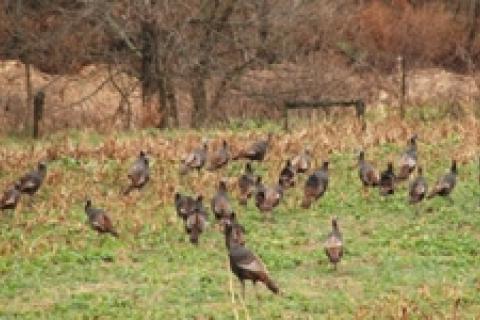
Fall turkey hunting is not surrounded by the hype and glamour of the spring turkey hunting season.
"Fall turkey hunting provides an exhilarating time to be in the woods," said world renowned turkey hunter Ray Eye. "The air is significantly cooler, the bugs are gone, the colors are gorgeous in the hardwoods and very few people hunt turkeys in the fall. What more could an outdoorsman want?"
 |
| While not as popular as spring turkey hunting, fall still provides plenty of gobblers for hunters. |
Fall Means Legwork
"Fall turkey hunting is entirely different than spring hunting," stated Bloodline TV show host Alex Rutledge. "Turkeys are mating in the spring and toms gobble to attract a harem of hens. It is the gobbling factor that excites hunters about spring turkey hunting."
Turkeys gobble in the fall, too, but no to the extent of spring. "Fall turkeys are very vocal," stated Eye. "If a hunter wants to learn turkey language, he needs to be in the woods in the fall. Young of the year and hens trying to assemble them call loud and long. Too, birds are always struggling for their place in the pecking order and that involves lots of calling and posturing on a daily basis."
"Turkeys bunch up in the fall," explained Rutledge. "If you don't find the flocks, it is easy to assume that there are no turkeys in the area. Big mistake. Fall turkey hunting is all about covering ground and finding the birds. With the decline in turkey numbers in the last several years, scouting well before the fall turkey season arrives is key to harvesting your birds when the season opener arrives."
Scouting Most Important
"A key to fall turkey hunting is hunting where the birds are located," Rutledge stated. "You are only as good as the property you are hunting. You must have animals on the property to be successful. There can be no assuming that turkeys are there. You have to know that they are there and you can do that through scouting."
"Getting a visual on turkeys is the most sure-fire way of being positive that there are turkeys on any given property," Rutledge stated. Using a trail camera, such as Spy Point's Trail Camera, is another option. hanging several trail cameras will help you find out in a hurry what animals are using a property."
"Figuring out the travel and feeding patterns of fall turkeys is another aspect of scouting before the season begins," Rutledge noted. "I like to know where turkeys are hanging out anytime of day. Scouting early and often will give you the advantage of having that knowledge. Knowing where birds are apt to be any time of day allows you to hunt successfully any time of day. You may miss birds early in the morning. They may have moved from one roosting place to another, but may pick up their daily travel routine a bit later. By knowing their general movement patterns you will have better luck locating a flock later in the day."
Finding roosting areas provides a big advantage for early morning hunting. "Getting in close on a flock of fall gobblers is as fun as it gets," Rutledge said. " I usually communicate with them while they are on the roost. Couple calling with a group of Avian Decoy strutters and jakes and they will come."
"I like to gobble at a flock. Gobblers will both gobble and strut in the fall. I take advantage of their strong instincts towards the pecking order. Gobbling on the Haint call, using fighting purrs and aggressive clucks often works them into a fighting frenzy. They hear and then they see. The combination coaxes them to come."
 |
| Look for discarded feathers when scouting for turkey. |
Look for Telltale Signs
There are several other signs to look for if you do not visually locate turkeys on a property. "Turkeys leave all kinds of telltale sign around areas where they stay," Rutledge explained. "Tracks are one of the most obvious signs of turkeys to look for. The middle toe on gobbler tracks will be about 3 and 1/2-inches long. Hen tracks are normally less than three inches long."
Droppings are other sign to look for. "Gobbler droppings will be long and "J" shaped, " Rutledge related. "Hens leave a popcorn shaped dropping."
Discarded feathers are another sign to search for. "Feathers tell us a lot about the birds, Rutledge said. "Young of the year will have much shorter feathers. Gobblers have breast feathers with a bar of black on the end. Breast feathers from a hen will be buff tipped."
Scratchings are a sure sign of feeding turkeys. Basketball sized areas that are torn up indicate that turkeys have been scratching to find food. Leaves are often flung a couple of feet from the turkeys powerful feet and legs. "You can tell about how many turkeys are in a flock by the number of scratchings you find together, " Rutledge pointed out.
Dusting areas also indicate the presence of turkeys. Birds often make depressions in dry road beds or sandy areas where they can fling dust on their backs to control mites and lice.
"Water holes are an excellent place to check for turkey sign," Rutledge concluded. "Tracks are easily distinguishable at water holes. Too, feathers and droppings are often common around these damp spots."
Both Eye and Rutledge agree that fall turkey hunting is a splendid sport which more people should enjoy. "The approaching fall turkey season just gives me one more excuse to get out there early and do lots of scouting," Eye stated.
- 5637 views

